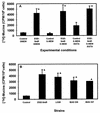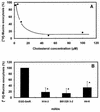Listeria monocytogenes stimulates mucus exocytosis in cultured human polarized mucosecreting intestinal cells through action of listeriolysin O
- PMID: 9673248
- PMCID: PMC108401
- DOI: 10.1128/IAI.66.8.3673-3681.1998
Listeria monocytogenes stimulates mucus exocytosis in cultured human polarized mucosecreting intestinal cells through action of listeriolysin O
Abstract
When the intracellular pathogen Listeria monocytogenes infects cultured human mucosecreting polarized HT29-MTX cells apically, it induces the stimulation of mucus exocytosis without cell entry. Using a set of isogenic mutants and purified listeriolysin O (LLO), we identified the L. monocytogenes thiol-activated exotoxin LLO as the agonist of mucus secretion. We demonstrated that the LLO-induced mucus exocytosis did not result from the LLO membrane-damaging activity. We found that LLO-induced mucus exocytosis is an event requiring the binding of LLO to a brush border-associated receptor and membrane oligomerization of the exotoxin. By a pharmacological approach, we demonstrated that no regulatory system or intracellular transducing signal known to be involved in control of mucin exocytosis was activated by LLO. Based on the present data, the stimulatory action of LLO on mucin exocytosis could be accounted for either by an unknown signaling system which remains to be determined or by direct action of LLO with the membrane vesicle components involved in the intracellular vesicular transport of mucins.
Figures






Similar articles
-
The increase in mucin exocytosis and the upregulation of MUC genes encoding for membrane-bound mucins induced by the thiol-activated exotoxin listeriolysin O is a host cell defence response that inhibits the cell-entry of Listeria monocytogenes.Cell Microbiol. 2005 Jul;7(7):1035-48. doi: 10.1111/j.1462-5822.2005.00532.x. Cell Microbiol. 2005. PMID: 15953034
-
Activation of mucin exocytosis and upregulation of MUC genes in polarized human intestinal mucin-secreting cells by the thiol-activated exotoxin listeriolysin O.Cell Microbiol. 2002 Aug;4(8):515-29. doi: 10.1046/j.1462-5822.2002.00210.x. Cell Microbiol. 2002. PMID: 12174086
-
Relative Roles of Listeriolysin O, InlA, and InlB in Listeria monocytogenes Uptake by Host Cells.Infect Immun. 2018 Sep 21;86(10):e00555-18. doi: 10.1128/IAI.00555-18. Print 2018 Oct. Infect Immun. 2018. PMID: 30061379 Free PMC article.
-
Listeriolysin O: a phagosome-specific lysin.Microbes Infect. 2007 Aug;9(10):1176-87. doi: 10.1016/j.micinf.2007.05.005. Epub 2007 May 7. Microbes Infect. 2007. PMID: 17720603 Review.
-
Multifaceted activity of listeriolysin O, the cholesterol-dependent cytolysin of Listeria monocytogenes.Subcell Biochem. 2014;80:161-95. doi: 10.1007/978-94-017-8881-6_9. Subcell Biochem. 2014. PMID: 24798012 Free PMC article. Review.
Cited by
-
Roles and regulation of the mucus barrier in the gut.Tissue Barriers. 2015 Apr 3;3(1-2):e982426. doi: 10.4161/21688370.2014.982426. eCollection 2015. Tissue Barriers. 2015. PMID: 25838985 Free PMC article.
-
Use of RNA interference in Drosophila S2 cells to identify host pathways controlling compartmentalization of an intracellular pathogen.Proc Natl Acad Sci U S A. 2005 Sep 20;102(38):13646-51. doi: 10.1073/pnas.0506461102. Epub 2005 Sep 12. Proc Natl Acad Sci U S A. 2005. PMID: 16157870 Free PMC article.
-
Biotechnological applications of Listeria's sophisticated infection strategies.Microb Biotechnol. 2008 Sep;1(5):361-72. doi: 10.1111/j.1751-7915.2008.00037.x. Epub 2008 Jun 9. Microb Biotechnol. 2008. PMID: 21261856 Free PMC article. Review.
-
Two atypical enteropathogenic Escherichia coli strains induce the production of secreted and membrane-bound mucins to benefit their own growth at the apical surface of human mucin-secreting intestinal HT29-MTX cells.Infect Immun. 2010 Mar;78(3):927-38. doi: 10.1128/IAI.01115-09. Epub 2010 Jan 11. Infect Immun. 2010. PMID: 20065027 Free PMC article.
-
Entamoeba histolytica-Induced Mucin Exocytosis Is Mediated by VAMP8 and Is Critical in Mucosal Innate Host Defense.mBio. 2017 Oct 3;8(5):e01323-17. doi: 10.1128/mBio.01323-17. mBio. 2017. PMID: 28974617 Free PMC article.
References
-
- Alouf J E, Geoffroy C. Structure activity relationships in sulphydryl-activated toxins. In: Allouf J E, Fehrenbach F J, Freer J H, Jeljaszewicz J, editors. Bacterial protein toxins. London, United Kingdom: Academic Press, Ltd.; 1984. pp. 165–171.
-
- Augeron C, Voisin T, Maoret J J, Berthon B, Laburthe M, Laboisse C. Neurotensin and neuromedin N stimulate mucin ouput in the human goblet cell clone Cl.16E: a neurotensin receptor-mediated event. Am J Physiol. 1992;262:G470–G476. - PubMed
-
- Beubler E, Kollar G, Saria A, Bukhave K, Rask-Madsen J. Involvement of 5-hydroxytryptamine, prostaglandin-E2, and cyclic adenosine monophosphate in cholera toxin-induced fluid secretion in the small intestine of the rat in vivo. Gastroenterology. 1989;96:368–376. - PubMed
MeSH terms
Substances
LinkOut - more resources
Full Text Sources

